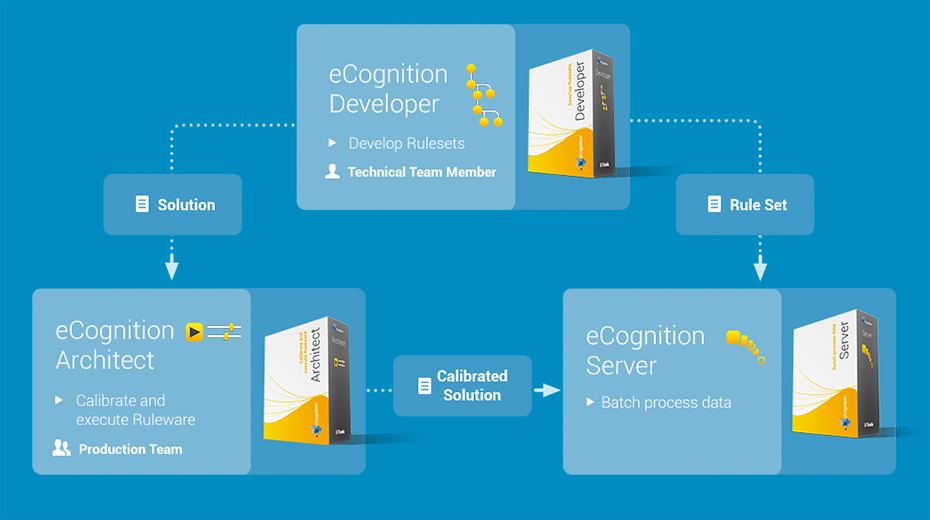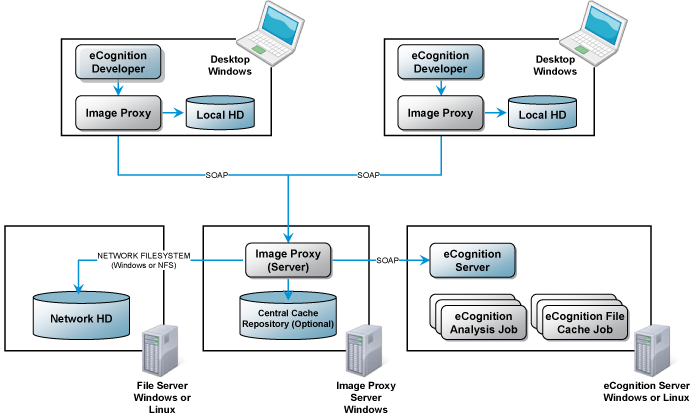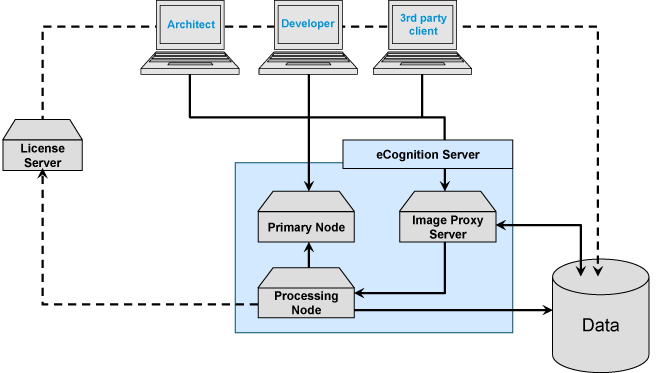Overview System Requirements
eCognition is a comprehensive image analysis platform for multi-dimensional image analysis. It contains all the client and server software needed to extract intelligence from any digital image in a fully-automated or semi-automated way.
The client software is role-based and supports the needs and skills of different users in an organization. The server software, known as the eCognition Server, is a processing environment that allows the batch processing of jobs and is hugely scalable, capable of handling tens, hundreds or many thousands of images in a single job.

Client Software
eCognition Developer
eCognition Developer is a powerful and completely integrated environment designed for image analysis specialists to develop, test and package new image analysis applications. eCognition Developer can be used as a standalone tool or in combination with the eCognition Server.
eCognition Developer incorporates the latest generation of Trimble Cognition Network Technology®, enabling the creation of new solutions for multidimensional image analysis applications. It incorporates a new programming paradigm, high-performance analysis for complex multidimensional data and sophisticated viewing, visualization and registration capabilities.
eCognition Architect
eCognition Architect is an intuitive end-user tool used to configure and execute image analysis applications. It provides support for fully automated or semi-automated workflows and guides users through the application they are running. eCognition Architect incorporates all the required tools for users to import, view and visualize multidimensional images and results.
Server Software
eCognition Server
The eCognition Server provides a processing environment for the batch execution of image analysis using a high-performance grid computing environment. All supported connectors and drivers are described in a separate document called “Supported Connectors and Drivers”.
Image Proxy Server
The Image Proxy Server (IPS) is a software component running on Microsoft Windows that provides high-performance image access and caching. A local IPS is installed automatically with each Trimble client.

The key functionality provided by the IPS includes:
- Delivering Windows-only file formats to eCognition Linux Servers (requires one Windows server)
- Creating and delivering zoom pyramids for large images
- Creating and delivering thumbnail caches for workspaces
- Creating and delivering an image statistics cache
- Creating and delivering cached zoom pyramids for thematic layers
- Creating and delivering cached raster representations of vector files
Data Storage and Cache Management
The Image Proxy Server creates and manages cache data, which can be stored in a sub folder with the original data or in a centralized repository connected to the Image Proxy Server (local disk or NAS). This cache can be sized appropriately for your environment. It uses a combination of maximum size, FIFO and minimum and maximum retention times. This caching can also be turned off by updating the default configuration.
License Server
Trimble software is soft license-protected using FlexNet Licensing Technology from Flexera Software. The License Server is used to provide the available licenses to the software and can be used locally on a single machine or in a network environment.
You must install the License Server before installing other Trimble software. It can be run on any machine within the network that is constantly available.
The License Server can also be installed on the primary node of the Grid.
Hardware Platforms
All Trimble products require an Intel x86_64 hardware platform (64 bit).
Operating Systems
Trimble software has been validated for the following operating systems:
Microsoft Windows Client Operating Systems for eCognition Developer & Architect
- Microsoft Windows 10 (64 bit)
Microsoft Windows Server Operating Systems for eCognition GRID
- Microsoft Windows Server 2016 (64 Bit) Standard Edition
-
Microsoft Windows Server 2019 (64 Bit) Standard Edition
Please note that the Windows Server operation systems require the installation of the Visual C++ Redistributable for Visual Studio 2015 that can be downloaded here Microsoft download.
Linux Server Operating Systems for eCognition GRID
Pre-requisite libraries are required for each specific Linux distribution. These are documented in Detailed System Requirements for Linux Systems.
- Red Hat Enterprise Linux 7
- Red Hat Enterprise Linux 8
- SUSE Linux Enterprise Server 12
- SUSE Linux Enterprise Server 15
- CentOS 7
- CentOS 8
Requirements for Graphics Cards / GPU
Graphics Cards / GPU for 3D Rendering
Trimble clients allow the display and analysis of a variety data types. Some features need an OpenGL capable graphics card:
- To properly display 3D analysis results, an OpenGL capable graphics card is required
- To render *.las files (point clouds) in the 3D viewer you also need to install an up-to-date OpenGL compatible graphics card driver
To update your graphics card driver to the current version select for example the Device Manager in the Windows Control Panel. In the section Display adapters select your graphics card and navigate to the tab Driver where you can select update driver. Technical details and update executables can also be found on the websites of the respective graphics card provider. To check the OpenGL version installed on your machine you can also install an OpenGL viewer for example: http://download.cnet.com/OpenGL-Extensions-Viewer/3000-18487_4-34442.html or http://www.ozone3d.net/gpu_caps_viewer/ A dedicated OpenGL capable desktop graphics card from NVIDIA or ATI is highly recommended. Intel Extreme Graphics and integrated graphics may give incorrect results.
Graphics Cards / GPU forTensorFlow Convolutional Neural Networks / Deep learning
The following requirements have to be fulfilled if you want to use eCognition‘s Convolutional Neural Networks / Deep learning Processing which is based on the TensorFlow® library:
- NVIDIA Graphics Card with compute capability 5 or higher
The following NVIDIA® software must be installed on your system:
- NVIDIA® GPU drivers —CUDA® 10.1 requires 418.x or higher
For details see: https://www.tensorflow.org/install/gpu
System Requirements
eCognition Developer / Server / Architect / Essentials / Oil Palm Application
CPU Speed
- Minimum: Dual core CPU
- Recommended: Quad core CPU
- Optimal: Hexa core (eCognition Server only)
Memory
- Minimum: 4 GB DDR-RAM
- Recommended: 16 GB DDR-RAM
- Optimal: 32 GB or more
Hard DISK
- Minimum: 50 GB S-ATA Drive
- Recommended: 200 GB SSD-Drive
- Optimal: 512GB SSD or more
Display
- Minimum: Full HD Display (1920x1080)
- Recommended: 4 K Display (3840x2160)
eCognitions user interface (desktop client) is optimized for certain screen resolutions and text sizes (Windows operating systems):
- resolution 1920x1080 and text size 100%
- resolution 3840x2160 and text sizes 150%, 200% and 250%
For other resolutions / text sizes, window sizes / toolbar layout may need to be adjusted and saved in eCognition > View > Save Current View.
Operating Systems
All validated Microsoft Windows client operating systems can be used, see Microsoft Windows Client Operating Systems for eCognition Developer & Architect .
eCognition Server
eCognition Server is a scalable grid computing infrastructure that may be installed on one or more machines in your network.
Each machine hosting components of the eCognition Server is called a node. A eCognition Server setup consists of a primary node and one or more processing nodes. While the primary node controls the operation of the eCognition Server, the processing nodes perform the image analysis tasks.

Administration Console
The Administration Console provides system administrators with a web-based interface that simplifies the management of the eCognition Server environment. It is installed as a central part of the eCognition Server and can be accessed by any machine in the network connected to the server and using a standard web browser.
Primary Nodes
The primary node hosts the infrastructure components required to operate the eCognition Server:
- Administration Server: Application server of the Administration Console
- Deployment Server: Manages and distributes image analysis software packages
- Job Scheduler: Manages and distributes active user jobs for processing nodes
- Spooler Service: Retrieves analysis results from processing nodes and stores them in a relational database (part of the Data Management)

Processing Nodes
The processing nodes host the processing components required to perform the image analysis service:
- The Configuration Service configures the Analysis Engine according to the requirements of the image analysis tasks. Downloads new packages from the deployment server if required.
- The Analysis Engine performs the image analysis tasks.
If you use multi-processor or multi-core machines, you can set up processing nodes with more than one analysis engine. Each analysis engine should then have a dedicated CPU core and one eCognition Server CPU license is needed per analysis engine. It is also possible to install analysis engines on the primary node and use it as a processing node. In this case, the deployment server also acts as the configuration service for this machine.

Control Service
The Control Service is a small component that runs on each node of the eCognition Server. It starts and monitors the other Trimble components of the respective node.
Interprocess Communication
The communication protocol for the components of the eCognition Developer 8.9 software suite is SOAP-based. All ports used by the system must be available and properly configured with respect to virus scanners and firewalls:
- Administration Console – 4002
- JobScheduler – 8184
- Configuration Service – 8284
- License Server `– COM port 1= 27000 and return COM port 2, allocated at random.
Please see the Installation Guide for additional detailed information on firewall setup.
Image File Access
To process images each eCognition Server node requires access to image data files. This access can be either direct access using network shares or using the Image Proxy Server. It is recommended that the Proxy Server be installed as performance and reliability of image access is improved.
System Requirements for eCognition Server
The following requirements apply to a single analysis engine.
Hardware Requirements
- 1 CPU Core
- 8 GB DDR-RAM
- 1 GB Ethernet network
Operating Systems
- All validated Microsoft Windows operating systems. For Microsoft Windows we recommend using a server operating system, see Microsoft Windows Server Operating Systems for eCognition GRID.
- All validated Linux operating systems, see Linux Server Operating Systems for eCognition GRID
System Requirements for the Administration Console
The system requirements for the Administration Console are defined by your preferred web browser. While the console should work with most standard web browsers, it has been validated for the following:
- Microsoft Internet Explorer
- Mozilla Firefox
- Google Chrome
Image Proxy Server
The Image Proxy Server (IPS) software provides high-performance image access and image caching services. IPS software is installed by default with each client and is also installed as a server to support image access form processing nodes and centralized cache services to clients..
Server Deployment
The Image Proxy Server is responsible for both serving image data but also creating necessary cache data to provide high-performance access.
Cache Processing
The IPS can use the facilities of the existing eCognition Server processing nodes to offload the cache creation processing, which reduces the processing load on the image server . On Linux, this offloading of processing to the eCognition Server is dependent on having all the image drivers you wish to use available natively on Linux. Please see the Supported Connectors and Drivers documentation for details of which drivers are available for which operating system.
Storage Architecture
The choice of storage architecture for image cache data also affects the amount of disk space required for the Image Proxy Server. The default option is to use decentralized storage.
- Decentralized – cache data is stored along side the original image data
- Centralized – cache data is stored in a centralized location
License Server
The License Server software provides software licenses to all Trimble products. It can be installed on any machine that is reliably available within the network domain that is used to operate the Trimble software.
Hardware Requirements
- Dual core CPU
- 4 GB DDR-RAM
Operating Systems
- All validated Microsoft Windows operating systems (see Microsoft Windows Client Operating Systems for eCognition Developer & Architect )
- All validated Linux operating systems (see Linux Server Operating Systems for eCognition GRID)
